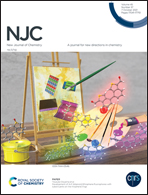Enhancing the photocatalytic efficiency of the BiOCl/Bi3O4Cl composite modified with WO3 for environmental purification under visible light
Abstract
Covering the BiOCl/Bi3O4Cl composite with a monolayer of WO3 resulted in a significant increase in the photocatalytic activity of WO3/BiOCl/Bi3O4Cl in the presence of visible light (λ ≥ 420 nm). The decomposition of gaseous isopropyl alcohol (IPA) and aqueous salicylic acid (SA) in the presence of visible light was maximized when 0.2 mol% of WO3 was attached to the surface of BiOCl/Bi3O4Cl. However, while the amount of WO3 on the surface of BiOCl/Bi3O4Cl was less or more than 0.2 mol%, the photocatalytic activity was found to be abruptly reduced. At this composition, WO3/BiOCl/Bi3O4Cl demonstrated 2.1 and 5.2 times better activity than the BiOCl/Bi3O4Cl composite and Degussa P25 (TiO2 nanoparticle) for evolving CO2 from the decomposition of IPA in gas phase under the identical conditions. These results suggest that 0.2 mol% WO3/BiOCl/Bi3O4Cl was the optimized composition to achieve the highest photocatalytic activity covering of BiOCl/Bi3O4Cl through the formation of a monolayer by molecular WO3. On the surface of BiOCl/Bi3O4Cl, the function of WO3 is to offer increasing OH−, H2O or organics towards WO3/BiOCl/Bi3O4Cl by increasing the adsorption affinity of WO3/BiOCl/Bi3O4Cl. Furthermore, the chemical durability of BiOCl/Bi3O4Cl was increased due to the covering of BiOCl/Bi3O4Cl with WO3. Considering the above findings, the role of WO3 in enhancing the photocatalytic efficiency of BiOCl/Bi3O4Cl has been explained in detail.



 Please wait while we load your content...
Please wait while we load your content...